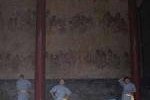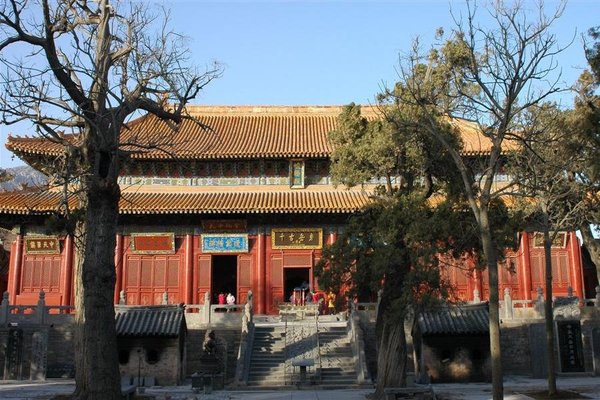China
Dengfeng
The Historic Monuments of Dengfeng in "The Centre of Heaven and Earth" reflect the tradition of mountain worship.
Mount Songshan was considered the best place for a terrestrial capital according to astronomical observations. A large number of sacred and secular buildings were constructed here, commissioned by Emperors who meant to reinforce their power. They include Buddhist shrines and an astronomical Observatory.
Community Perspective: The globally best-known component is the Shaolin monastery, “the birthplace of Kung Fu”. Juha managed to visit 5 of the other 7 locations, while Zos added a perspective on the Gaocheng Observatory.
Site Info
Official Information
- Full Name
- Historic Monuments of Dengfeng in "The Centre of Heaven and Earth" (ID: 1305)
- Country
- China
- Status
-
Inscribed 2010
Site history
History of Dengfeng
- 2010: Revision
- Includes the former TWHS Songshan (2001)
- 2010: Inscribed
- Inscribed
- 2009: Referred
- "Nominating the Observatory on its own", and other selective issues (as former TWHS Songshan)
- Type
- Cultural
- Criteria
- iii
- vi
Links
- UNESCO
- whc.unesco.org
- Official
-
- shaolin.org.cn — Shaolin Temple
All Links
UNESCO.org
- whc.unesco.org — whc.unesco.org/
Official Website
- shaolin.org.cn — Shaolin Temple
News Article
- Sept. 18, 2025 theguardian.com — China’s ‘temple economy’ in the spotlight as scandals rock influential religious leaders
- Aug. 4, 2010 speroforum.com — The Shaolin Temple ,"World Heritage Site", but overrun by tourists
- June 30, 2009 news.xinhuanet.com — Mt Songshan fails to enter World Heritage list: confusion caused by dual application of Songshan Mountain is the main reason for the postponement
Community Information
- Community Category
- Religious structure: Buddhist
Travel Information
Luoyang Hotspot
Recent Connections
-
Confucian Academy (Shuyuan, Seowon, Shijuku)
Songyang-shuyuan (Songyang Academy of C…
-
Epic Subtitles
in "The Centre of Heaven and earth" -
Astronomy and Astrology
Observatory: "an area to the south of M…
Connections of Dengfeng
- Architecture
-
-
Brick architecture
Songyue Pagoda - "the earliest known Chinese brick pagoda" (wiki)
-
- World Heritage Process
-
-
Extended from original TWHS
Originally only Songshan. An extended nomination followed a referral of the original nomination in 2009. -
First sites filling gaps cited by ICOMOS
mythic origin 2010
-
- Religion and Belief
-
-
Pagoda
Songyue Pagoda (brick) - twelve stories (40 meters); Northern Wei Dynasty *Pagoda Forest - 241 pagodas (brick, stone) - ten stories and below; Tang to Qing Dynasty -
Zen
Shaolin Temple of Dengfeng, China, is where the first Zen or Chan patriarch founded the Zen school -
Confucianism
Songyang Confucian Academy -
Sacred Mountains
Mount Song -
Taoism
Zhongyue Taoist Temple AB)
-
- Human Activity
-
-
Locations for playing sport
Shaolin Kung Fu
-
- Constructions
- WHS on Other Lists
-
-
Memory of the World
The Steles of Shaolin Temple (566-1990) (2025)
-
- Timeline
-
-
Built in the 2nd century
The nominated buildings were initially constructed over a span of eighteen centuries between 118 AD and the 20th century. The Tishi, Shaoshi and Qimu Gates have survived since Han times
-
- WHS Hotspots
-
-
Luoyang Hotspot
1.5 - 2 hours by bus to Shaolin Temple
-
- Science and Technology
-
-
Astronomy and Astrology
Observatory: "an area to the south of Mount Shaoshi and Mount Taishi, two peaks of Mount Songshan, came to be associated with the concept of the centre of heaven and earth – the only point where astronomical observations were considered to be accurate" (OUV) -
Confucian Academy (Shuyuan, Seowon, Shijuku)
Songyang-shuyuan (Songyang Academy of Classical Learning)
-
- WHS Names
-
-
Epic Subtitles
in "The Centre of Heaven and earth"
-
News
- theguardian.com 09/18/2025
- China’s ‘temple economy’ in the sp…
- speroforum.com 08/04/2010
- The Shaolin Temple ,"World Heritag…
- news.xinhuanet.com 06/30/2009
- Mt Songshan fails to enter World H…
Recent Visitors
Visitors of Dengfeng
- Alejandro Lau
- Alexander Barabanov
- Alexander Lehmann
- Alex Goh
- Alex Marcean
- Antonio J.
- Aspasia
- Atila Ege
- basementonline
- Bin
- Chalamphol Therakul
- chenboada
- Christravelblog
- David Marton
- Dimitar Krastev
- dmux7
- Dolemite92
- Dwight Zehuan Xiao
- Elisabeth Fransisca Situmorang
- Erik Jelinek
- Fan Yibo
- FK
- Hadrianus
- Harald T.
- henryjiao18
- heywhatever2
- Iain Jackson
- Jeffrey Chai
- Joel on the Road
- Jonas Kremer
- Joyce van Soest
- Juha Sjoeblom
- jxrocky
- Kasper
- Ken DJ
- Kevin McFarland
- KngAlaric
- lichia
- Ludvan
- Luke LOU
- Maciej Gil
- Matthewsharris
- MaYumin
- Michael Novins
- Miloš Tašković
- Mo-han Je
- nan
- _oscar
- Pchxiao
- Petteri
- Risson
- Samuel Turtschi
- Sergio Arjona
- Shandos Cleaver
- Shijie ZHU
- Szucs Tamas
- Taotao Chen
- Tatiana Nikulnikova
- Thomas van der Walt
- Timonator
- trekkie900
- Vincent Cheung
- voyager
- Weecheng
- Xander Huang
- Xiong Wei
- Xiquinho Silva
- Yang Chengyu
- Yongcheng Liu
- Zoë Sheng
- Zos M
Community Reviews
Show full reviews
First things first, Dengfeng to me was a site I couldn't place at all when reading past it. But everyone who has seen a single kungfu movie knows what this includes: the fabled Shaolin Temple. So my proposal to Unesco and the Chinese authorities would be to rename the site. Spitballing some ideas here: Shaolin Temples, Shaolin Temples of Dengfeng, Shaolin-Dengfeng, ... Probably, the authorities don't care about the name recognition of this site as much, though, as it is really popular nonetheless.
I made my way in January on a day trip from Xian. My day was fairly packed as I also visited the Longmen Grottoes the same day, another Buddhist monument nearby. Both sites were a nice combination as they presented different angles on the Buddhism in China topic.
Reading the other reviews, many seem to prefer other parts of the site. Visiting in off season and the temple still being plenty crowded, I can see the point. Still, I wanted to visit the Shaolin Temple and I did. Had I had more time, I would have loved to visit more, most specifically the observatory. In sum, I felt I did not spend enough time with the site to get a full picture. That's why I rated it 4* instead of 3.5* which I would have awarded the Shaolin Temple on its own.
Getting There
Arriving from Xian at Longmen Luoyang bullet train station a driver contacted me when I left the station. We …
Keep reading 0 comments
This is a site that I really enjoyed exploring. It’s not difficult to check out all the inscribed sites, and Mount Songshan has a lot to offer: landscape, religions, architecture... Again I’ll only make comments complementary to previous reviews. Sites are mentioned in chronological order.
Que Gates are important cultural relics that embody ancient Chinese ceremonial or funerary traditions. They are also considered as lithic replications of wooden structures that no longer exist nowadays. The three Han Que Gates at Mount Songshan were built during the Eastern Han Dynasty, the heyday of Que Gates. Due to their importance, all three were protected in sheds around 2010 to alleviate erosions caused by nature and fast-growing tourism. Now the only visible Han Que is Shaoshi Que, which can be seen through newly installed glass curtain walls. One can still appreciate on its body the carved paintings with religious or aristocratic themes.
Juha’s summary of the Songyue Temple Pagoda is very precise. I’d like to add that its dodecagonal shape stands as proof of imported Indian influence on early Chinese architecture, and makes an isolated and unique case in the evolution of domestic Chinese pagodas.
The Shaolin Temple is indeed considered as a tourist trap to some extent, as the majority of the kernel compound is a 20th-century reconstruction and the Kung Fu shows are highly commercialized. But it is still worth visiting because of the Pagoda Forest and the Chuzu Temple. The Pagoda Forest consists of 248 pagodas, some …
Keep reading 0 comments
[Visited April 2017]
I spent 3 days exploring all inscribed components during a 4-day Qingming holiday weekend. My visit was possibly a few days before Juha’s and I concur to his impressions on the review below. As he had excellently written about the components he visited, I will focus mine on the others in a lengthy review.
SHAOLIN TEMPLE COMPLEX
Shaolin Temple is the birthplace of Kung Fu. Visiting it was worth the hype and hassle. Yes, it is crowded and considering I went on a public holiday, it was really ”people mountain people sea” type of place. The payoff is not solely on the exceptionality of the built heritage. After all, when you’re templed out, seeing one you’ve seen them all. Rather, it is on the overall experience, especially on the little surprises, that I was rewarded.
Within the Shaolin Temple scenic area are Kung Fu academies offering short or long term courses. If martial art is not your forte, you can just delight on watching the students/kids practice. Morning is best to see them doing exercises - it is not for show but as part of the school schedule. It is an amazing sight viewing them in rows with synchronised movement and dexterity.
As expected Shaolin Temple Kernel Complex is the most crowded. Notable relics are the mural depicting the Shaolin tradition and a bronze monk statue. Deeper into the compound are places of solitude where I was rewarded with a man practicing Kung Fu (in photo). It …
Keep reading 0 comments
Site visited April 2017. The historic monuments of the city of Dengfeng was a pleasant experience. There were absolutely the smallest amount of visitors among the sites that I have visited in China. The places were calm and quiet and some of them are surrounded by beautiful nature. I visited five of the eight inscribed properties.
First of all I must tell that in this review I'm not going to mention anything about visiting the Shaolin Temple. Actually I had heard nothing but bad things about it being a major tourist trap. So I deliberately left that off from my itinerary. I was curious to see what other things there are in this WHS.
Despite of being named after the city of Dengfeng, this inscription is all about Mount Songshan and the monuments connected to and located around it. Mount Songshan is one of the most sacred Taoist mountains of China. The city of Dengfeng at the foot of Mount Songshan is a spiritual center where the most important temples and religious institutions are located.
I would say sarcastically that it is quite difficult to get to the city of Dengfeng. Not because of bad transport options, actually those are very good, but because everyone assume that you want to go not to Dengfeng but to Shaolin Temple. All the people in Luoyang is trying to push you to Shaolin, even the ticket salesman at the bus station counter. So after some worthless efforts to buy a bus ticket to …
Keep reading 0 comments
I visited Dengfeng in 2009 and I didn't know it was going to be a WHS at that time. The reason I came here was the famous Shaolin monastery. Besides Chinese tourist groups, there was little tourist infrastructure for the individual tourist (it was hard finding a hotel and restaurant) so I didn't know about the other important places in the area. Visiting the Shaolin temple was impressive though. The complex is large and I especially liked the large wall with frescos (see picture). There's also a large pagoda forest and some other temples. Going up the mountain you will get to the cave where Boddhidarma meditated for nine years and where apparently zen Buddhism started and also Shaolin boxing
Keep reading 0 comments
